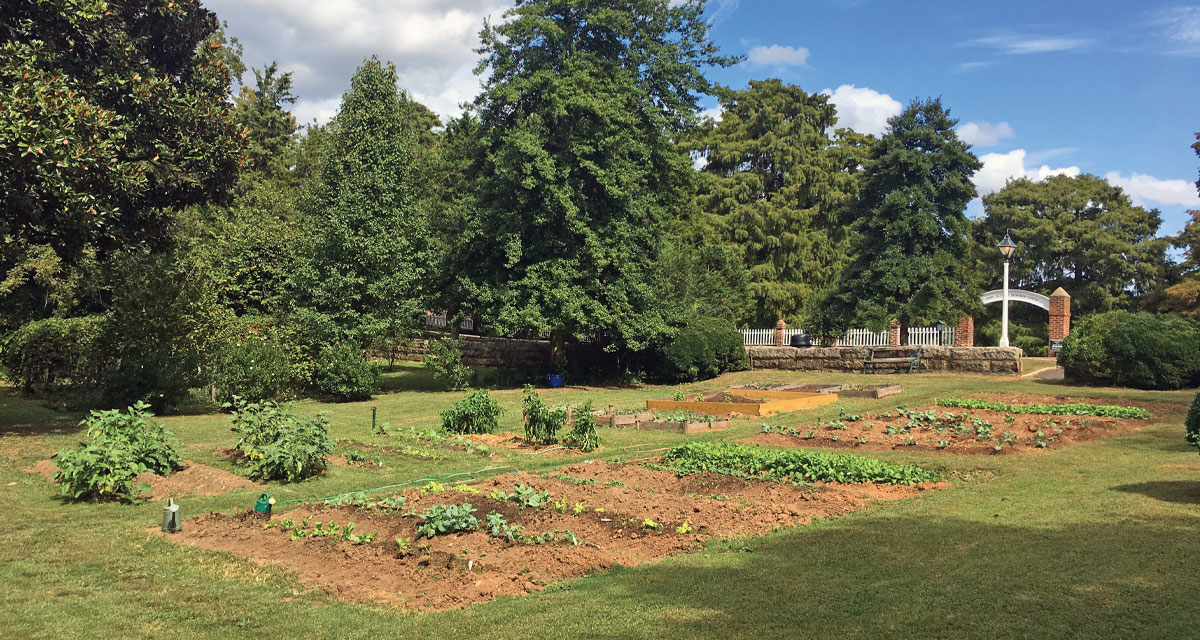Main Street in Winston-Salem is a breathtaking walk through the Historic District of Old Salem. Visitors and residents cannot help but explore the community, founded in 1766 by the Moravians, and notice the varying influences of architecture. It’s a unique mixture of European, Greek Revival, and other remnants of early American styles. Ask for the “Belo House,” and shopkeepers will describe a white house accented with black wrought-iron fencing and express, “You cannot miss it!” This magnificent house offers travelers another reason to visit the Historic District; behind the house on Church and Bank Street is a gem. Spanning two acres of donated land lies the Wachovia Garden!
Tuesday Evening Gardening
At 5:00 PM, men and women arrive to offer greetings; then congregate at a shaded round table to discuss the garden’s needs, from weeding to harvest and deliveries, preferable work areas, gardening tasks, and short- and long-term goals. This like-minded fellowship began in 2010, when five individuals initiated the desire to establish a working garden behind the Belo House. Active member, Tracy Lounsbury, explains, “Salem Congregation owns Wachovia Garden’s land. We petitioned them to create something valuable, a year-round garden embracing stewardship, authenticity, community, simplicity, and sustainability. With the focus on environmental gardening practices, our harvest of fruits and vegetables is donated to Winston-Salem’s Sunnyside Ministry, serving people in need. After 12 years, we are 25 members strong, driven by the goal to grow an exceptional harvest.”
Community Support
Emulating the gardening practices of Old Salem, volunteers use a no-till method, in which the soil is layered with straw, compost, and mulch, enriching the soil and significantly reducing weed growth. In addition, the gardeners use heirloom seeds, native and beneficial plants, to create a sustainable gardening environment. The Wachovia Garden is grateful to organizations like Candle Tea, the Old Salem Garden Club, and various generous individuals for ongoing support. This year, a significant project is establishing a composting system, which will maintain the soil’s health, whether in beds or in-ground.
An Educational Resource
The fruits of the gardeners’ labor are evident in the established herb and vegetable beds, heirloom fruit trees, ten productive fig trees, berry bushes, a grape arbor, a pollinator garden, and several educational hives. The white brick walls of the Belo House create a microclimate reflecting heat onto the thriving heirloom trees and plants. Open to the local community, The Wachovia Garden welcomes children from local schools and summer programs into the Wachovia Garden to receive demonstrations and gain firsthand experiences, such as learning about native plants, planting gourds on the trellis, and weeding, watering, and collecting the harvest.
Why I Garden
Active member, Barbara Strauss, writes, “I work in the garden because it is my place to be. I like the look, the smell, and the feel of it. I like to encourage folks who don’t have much experience to grow plants, whether flowers, herbs, fruits, or vegetables. There are no dumb questions. There are no inherent facts about gardening that people are born with. We all learn through reading, studying, and firsthand experience. There is a bit of competitiveness to gardening. We constantly ask, ‘Can we do better than last year?’ The bottom line—Wachovia Garden is just a lovely place to visit and work!”
Welcoming New Members
Winston-Salem residents who want to carry on the Moravian spirit of fellowship and helping others should consider joining the Wachovia Garden group, especially if you love working the soil and watching seeds germinate into viable produce. Please contact Barbara Strauss at [email protected] to receive additional information. They’d love to welcome you into their family!
Connect with Wachovia Garden’s Facebook page to learn more about special events at the garden, such as the opportunity for heirloom tomato tastings, live music, class registrations for adults and children, and the Fall Fig Festival.



















